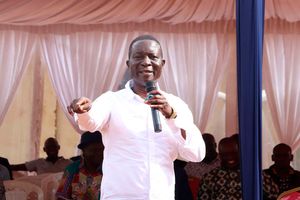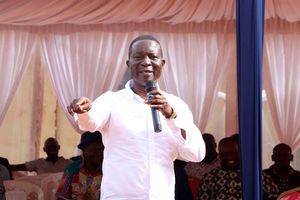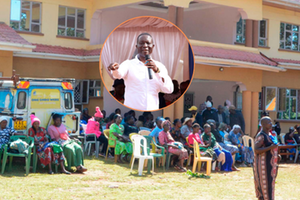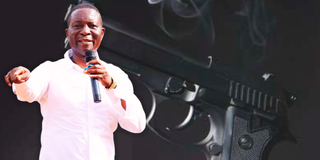
MP Charles Ong’ondo Were had publicly warned of threats to his life. He was gunned down by a motorcycle assassin near Nairobi Funeral Home, minutes after leaving Parliament.
Late afternoon on Wednesday, two men sat in a restaurant along Nairobi’s Kimathi Street, eating lunch and desperately waiting for National Assembly Speaker Moses Wetang’ula to close the day’s legislative business.
Many eyes were on the parliamentary proceedings and, particularly, Mr Wetang’ula’s words. For most Kenyans watching, the wait was to confirm whether the Finance Bill 2025 would be tabled.
Prepared by Treasury Cabinet Secretary John Mbadi, the document details some of the government’s planned revenue raising and expenditure plan over the next fiscal year.
For the MPs, Mr Wetang’ula closing the day’s business would be akin to a football referee blowing the whistle to end a game, as the legislators were to proceed on a month-long recess.
But for the two men having lunch, and who are now considered key murder suspects, it would mean they were free to proceed with their plot: attack and kill Kasipul MP Charles Ong’ondo Were.
They were into the final moments of what Directorate of Criminal Investigations (DCI) detectives now believe was a meticulously planned assassination.
Preliminary investigations into the MP’s mob-style execution on Wednesday night indicate that the two men, together with their accomplices, may have stalked their target for several days, as they even knew the MP’s movements — including the car Mr Were was using at the time and his sitting position in it.
The killers may have conducted reconnaissance missions on Mr Were and places he frequented, preliminary investigations have shown.
Police sources, who spoke in confidence, have indicated that Mr Were recently sold a car many know as his, and acquired the white Toyota Crown he arrived in at Parliament Buildings in on Wednesday.
Footage from multiple cameras in the city have captured the two suspect’s movements, giving the police crucial clues.
Footage from cameras in the restaurant the two feasted in is already in police custody, indicating that detectives already know what the alleged assassins look like.
One of the men, a detective close to the investigation told the Nation, had a small bag.
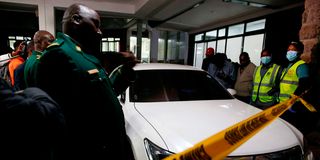
Parliamentary staff and forensic experts outside the Nairobi Hospital on April 30, 2025 as they secure the vehicle in which Kasipul MP Charles Ong'ondo Were was shot dead at close range by two gunmen on motorbike.
“The detailed analysis has yielded significant leads, enabling investigators to narrow down to potential suspects. While the motive for this heinous act remains under investigation, preliminary investigations suggest that this was a targeted and premeditated act,” DCI communications director John Marete said in a statement on Friday.
When Mr Were left Parliament at around 7:15pm, the assassins were long done with their lunch and hiding in plain sight, ready to attack the MP.
The two men were riding on a high-performance motorcycle, and detectives from the Directorate of Criminal Investigations (DCI) are analysing multiple CCTV footage to establish the make, model and number plate of the motor vehicle.
In a stark contradiction of usual security protocols for VIPs across the globe, Mr Were opted for the front passenger seat, instead of the back left position. His bodyguard sat at the back.
The assassins established this, as they trailed their target through the city centre and into the chokehold that was the Nairobi Funeral Home (City Mortuary) roundabout.
Mr Were and his small entourage drove past City Hall, turning into Wabera Street where the vehicle stopped briefly.
The bodyguard disembarked and stepped into an M-Pesa stall to deposit Sh20,000 in Mr Were’s phone.
The M-Pesa attendant has already recorded a statement with the DCI, and furnished the detectives with CCTV footage.
The driver and bodyguard have also recorded statements with the DCI.
After the transaction, the bodyguard returned to the back seat, and they left the city centre. All the while, the assassins were in tow — patiently waiting for the perfect opportunity to strike.
The car is seen in CCTV footage joining Kenyatta Avenue at around 7:19pm, and crossing the GPO roundabout where another MP, Kabete’s George Muchai, met his death at the hands of assassins just over 10 years ago.
Mr Were’s driver turned into Jakaya Kikwete Road after apparently spotting traffic snarl up along Valley Road. The assassins were still following, and still successful in avoiding detection.
As the car is next spotted along Argwings Kodhek Road minutes later, it is likely that Mr Were’s driver joined Lenana Road after exiting Jakaya Kikwete Road.
At 7.40pm, Mr Were and his team were at the Nairobi Funeral Home (formerly City Mortuary) roundabout, where they encountered more traffic.
That traffic created the perfect chokehold for his killers to strike.
One man got off the motorcycle, and quickly walked towards the white Toyota Crown, standing right next to the front passenger door.
The man, now in a balaclava, fired four shots at close range. These shattered the window, and went into Mr Were’s hand and chest.
The getaway man was ready. No sooner had the shooter sat on the motorcycle than the getaway man turned it, speeding off towards the Nairobi city centre.
The bodyguard, who was sitting behind the MP, reportedly told investigators that the shooting caught him unawares, and that he had to take cover before disembarking to give chase to the assassins.
He ran after the killers in vain, other witnesses have told the police.
Discovering that the motorcycle long gone, Mr Were’s bodyguard ran back to try get medical assistance for his boss.
The MP was bleeding profusely, and pleading for help.
His team rushed Mr Were to Nairobi Hospital, just a few metres away. But it was too late, as doctors pronounced the MP dead on arrival.
The driver and the bodyguard were unharmed in the attack and which witnesses say took less than a minute on a busy road experiencing some traffic.
Homicide detectives, who visited the scene on Thursday morning to reconstruct the events, recovered three spent cartridges, which will be subjected to ballistic examination.
Later, detectives camped along Wabera Street where the MP was last spotted before his assailants shot him dead.
The probe has also been extended to Kasipul Constituency, where Mr Were is believed to have made his fair share of enemies, as police investigate whether his murder is politically motivated.
On Friday, a cross-section politicians mourned their colleague.
Uriri MP Mark Nyamita said he and others are still shocked at the incident.
“If a sitting member can be shot when he is with security, we are very worried,” Mr Nyamita said.
While most MPs are entitled to at least one bodyguard, many legislators opt to move around without their personal security detail.
They are entitled to determine specific individuals in their personal security detail.
An MP can also request for more officers depending on the risks around his or her life.
The House leadership, however, enjoys more officers at their disposal and also have vehicles with government number plates, in addition to others with civilian registration plates.
Many lawmakers walk without their security in the city centre, some even mingling with members of the public in Nairobi’s backstreets.
Mr Were’s assassination, some lawmakers have intimated, has given them something to think about.
“Even me, I don’t walk with my security in Nairobi. I'm normally alone. I only use them when going to the constituency for crowd control purposes.,” an MP, who requested anonymity, said in an interview with the Nation.
“The problem with having the bodyguard is that he will tell you he cannot use public means while armed. That means you have to drop him at his place first which still leaves you alone. The drivers also don’t accept to drop the security before going home alone. To avoid that, we just have our guns and go home with the driver only,” added the MP.
Around Parliament Square, the majority of MPs walk alone without bodyguards, even beyond areas covered by CCTV monitoring parliament and its environs.
The cameras in Parliament covers certain parameters around the building that we cannot reveal for security reasons.
Last year, Parliament acquired all buildings around its premises creating an exclusive Bunge Square as part of enhancing security of MPs.


